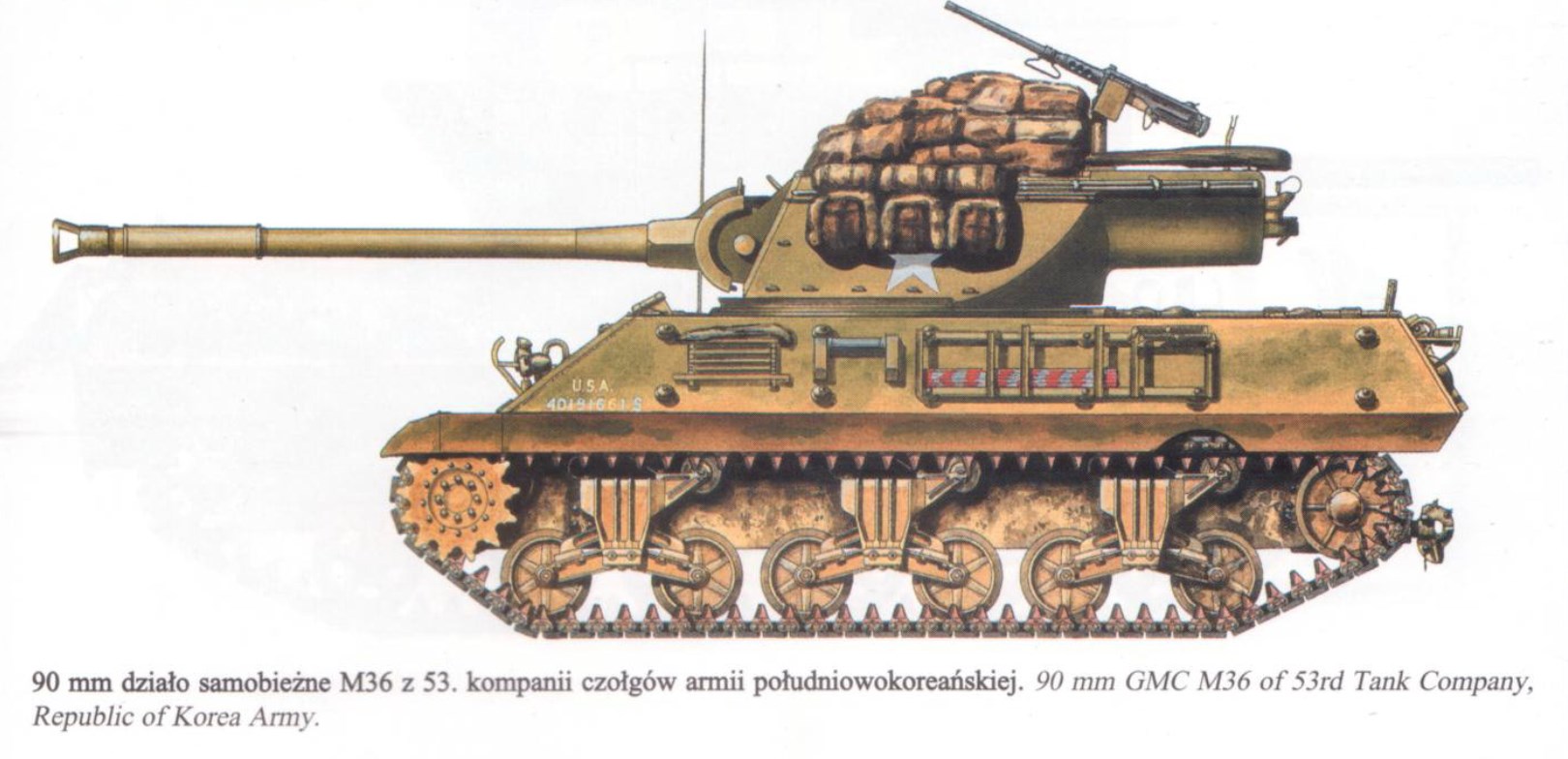
In October 1942 it was decided to investigate the
possibility of adapting the 90mm AA gun as a high velocity anti-tank gun for
mounting in American tanks and SP vehicles. In early 1943 a trial installation
of a 90mm gun was made in the turret of the M10, but the gun proved too long
and heavy for the turret which was, in any case, not entirely adequate for the
3in gun. In March 1943, therefore, work began on designing a new large turret
to fit the M10 and take the 90mm gun. Tested at APG, the modified vehicle was
very satisfactory and an initial “limited procurement” order of 500
vehicles was placed under the designation T71 GMC. In June 1944, the vehicle
was standardised as the M36 GMC and entered service in NW Europe in late 1944
where it proved a most successful type able to knock out the heavy German
Panther and Tiger tanks at long range. Some tank destroyer battalions notched
up impressive scores with little loss to themselves using the M36. A priority
programme to provide more M36 type vehicles to replace the less satisfactory M10
led to the following variants:
M36: Initial
production type based on M10A1 chassis which was in turn based on M4A3 medium
tank chassis. 300 produced by Grand Blanc April-July 1944 by completing M10A1
hulls as M36 vehicles with new guns and turrets. 413 produced by American Loco
Co by converting existing M10A1, October-December 1944. 500 produced by
Massey-Harris by converting existing M10A1, June-December 1944, 85 built by
Montreal Loco Works, May-June 1945.
M36B1: An
expedient design to meet increased demand for 90mm gun tank destroyers, this
was produced by utilising the standard hull of the M4A3 medium tank fitted with
the open-topped M36 type turret. 187 produced by Grand Blanc Arsenal,
October-December 1944.
M36B2 utilised M10 hull and had detail changes including (usually) an armoured canopy over the open-topped turret.
M36B2: Further
expedient type utilising the M10 instead of the M10A1 hull. Several detail
improvements including armoured covers for turret on some vehicles. 237
produced by converting existing MIO by American Loco, April-May 1945.
76mm Gun Motor
Carriage T72: This was an interim design to overcome the shortcomings of
the M10 which suffered from an unbalanced turret. The T72 was a M10A1 with a
redesigned turret based on the T23 medium tank turret but with the top removed
and thinner walls. There was a large rear “box” for a counterweight
and the 76mm gun M1 was replaced by the 3in. However, it was decided to replace
the M10 with the M18 Hellcat and the M36 so the T72 project was dropped.
SPECIFICATION
Designation: 90mm Gun Motor Carriage M36, M36B1, or M36B2
Crew: 5 (commander, driver, gun crew (3))
Battle weight: 62,000lb
Dimensions: Length 20ft 2in. Height 8ft 11 in Width 10ft
Armament: Main: 1 x 90mm gun M3 Secondary: 1 x ·50 cal
Browning MG (AA)
Armour thickness: Maximum 50mm Minimum 12mm
Traverse: 360° Elevation limits: +20° to -100
Engine: Twin GM 6- 71 diesels (M36B2), Ford GAA V8 petrol(M36,
M36B1)
Maximum speed: 30mph
Maximum cross-country speed: 18mph (approx)
Suspension type: Vertical volute
Road radius: 150 miles
Fording depth: 3ft Vertical obstacle: 2ft
Trench crossing: 7ft 6in
Ammunition stowage: 47 rounds 90mm, 1000 rounds ·50 cal MG
Special features/remarks: Overcame turret and gunpower
deficiencies of the M10 series and proved a potent and impressive type in
service. Many M36 vehicles were conversions from M10 series. Principal American
tank destroyer type in final year of the war. Distinguished from M10 series by
turret shape and long gun, occasionally seen with muzzle-brake removed.